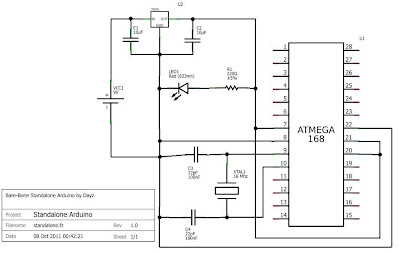



1. Multimeter were adjusted to DCV at 2.5.
2. The red and black lead of multimeter were connected to the electrode tip by follow the same wire colour of the electrodes.
3. Muscular Stimulator circuit are switch “on” by push the on/off button.
4. Current intensity control were adjusted until multimeter show a measurement.
5. The measurement show the DCV scale were increase at 25V.
6. Then 25V were multiplied by 2.5 which is the range that has been selected.
7. The calculation is 25 x 2.5 = 62.5. It shows that the output voltage of the Muscular Stimulator circuit were 62.5V positive.

Posted by Muhammad Fizrie Zainuddin at 8:39 AM 0 comments

Audio amplifier circuit is a circuit that are combined with the Muscular Stimulator circuit for producing the relaxation sound, rain sound effect. It is an electronic circuit for amplification of signals within or somewhat beyond the audio frequency range (generally regarded as 20 to 20,000 Hz). Audio amplifiers may function as voltage amplifiers (sometimes called preamplifiers), power amplifiers, or both. The function of audio amplifier to amplify a weak signal to a level capable of driving a loudspeaker or other type of transducer such as headphones at the desired sound level. Power amplifiers may have power ratings ranging from less than 1 W to several hundreds of watts.
Audio amplifier circuit use TDA2822 as the audio amplifier IC. TDA2822 is a dual low voltage power amplifier that are designed for portable cassette players and radios. It has several features such as wide operating supply voltage – Vcc = 1.8V to 12V, low crossover distortion, low quiescent circuit current and bridge/stereo configuration.

Posted by Muhammad Fizrie Zainuddin at 7:46 AM 0 comments
When anyone are looking for the right nature sounds, their initial impulse is typically to find a setting or multiple settings that consist of rain in them. Rain is a fairly mysterious thing. It has a highly comforting effect on people, and that's precisely why rain sounds have become so well known.
For starters, why is rain so well known as a nature sound setting? I think this is true because as people it is a natural relaxing sound for us. It's possible that it is as a result of the repetitive and delicate sound, and that you can easily safely enjoy it without the need for actually being outside and becoming soaked!
This aid can be the best partner for the muscular stimulator as it will give relaxing effect while doing stimulation.
Posted by Muhammad Fizrie Zainuddin at 7:34 AM 0 comments



Posted by Muhammad Fizrie Zainuddin at 1:15 AM 0 comments
Posted by Muhammad Fizrie Zainuddin at 10:54 AM 0 comments
Posted by Muhammad Fizrie Zainuddin at 10:38 AM 0 comments

Electronics component for Muscular Stimulator circuit

UV board for circuit eching

Tools
Posted by Muhammad Fizrie Zainuddin at 9:09 AM 0 comments
Know your suitable current limit
| |||||||||||||||||||||
Posted by Muhammad Fizrie Zainuddin at 8:35 PM 0 comments
History(Research Timeline)
· 1780 – Italian anatomist Luigi Galvani found that an electrical current would cause the muscle in a detached frog’s leg to contract.
· Early 1800s – Attempts were made to use electricity to re-animate hanged criminals.
· 1880s – Devices began appearing that used electrical stimulation of muscle tissue to aid in exercise. These were usually hand held devices that used mild electric shocks to cause muscle contractions (sometimes called electric dumbbells). These were actually produced into the early 1900s.
· Late 1800s to Early 1900s – Researchers investigated the effects of electricity on the heart.
o 1931 – First pacemaker
o Late 1950s to 1960s – Doctors applied principles of electrical stimulation to regulate heart rhythm and re-start the heart.
· 1960s and 1970s – Devices were developed to reduce or block pain signals. These involve internal and external stimulation to the spinal chord and peripheral nerves.
o TENS Devices (Transcutaneous Electrical Nerve Stimulators)
§ Surface Devices (applied directly to the skin)
§ Use an electrical signal to block or interfere with pain signals
§ Also found to stimulate endorphin production
· 1960s and 1970s (Soviet Sports Research) – Soviet exercise physiologists began experimenting with electrical muscle stimulation to increase muscle size and strength.
o Didn’t translate to specific skills
o Didn’t promote development of supporting tissues (tendons, ligaments, etc.)
· 1980s to Today
o Pulsed Galvanic Stimulation - Found to promote the dilation of blood vessels and speed up the healing of wounds (first used on patients with skin ulcers or bedsores).
o Electrical Stimulation of Bone Tissue – May promote bone growth (and is especially useful where fracture healing is difficult).
o Electrodes in the Brain – Help control epileptic seizures and may relieve depression by stimulating the vagus nerve.
Posted by Muhammad Fizrie Zainuddin at 8:23 PM 0 comments
Posted by Muhammad Fizrie Zainuddin at 7:49 PM 0 comments
What is it?
Muscular Stimulator, also known as neuromuscular electrical stimulation (NMES) or electromyostimulation, is the elicitation of muscle contraction using electric impulses.
It is a rehabilitation and preventive tool for partially or totally immobilized patients and a testing tool for evaluating the neural and/or muscular function in vivo which is a post-exercise recovery tool for athletes.
Posted by Muhammad Fizrie Zainuddin at 5:59 AM 0 comments